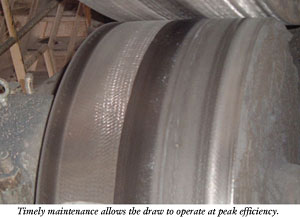 The asphalt plant’s drum is one of the most critical components of the asphalt plant. To keep it running at peak performance, its operating components—chair pads, stop blocks, trunnions, trunnion bearings, thrust bearings and tire—must also be kept in top condition.
The asphalt plant’s drum is one of the most critical components of the asphalt plant. To keep it running at peak performance, its operating components—chair pads, stop blocks, trunnions, trunnion bearings, thrust bearings and tire—must also be kept in top condition.
When these components are improperly adjusted or wear over time from normal operations, it becomes necessary to grind and resurface the tire and trunnions. Resurfacing the tire removes taper, convex/concave wear and flat spots and restores proper contact between the tire and the trunnions.
Resurfacing also evens and distributes loading and thrust to trunnion bearings and thrust rollers, and relieves tire thrusting against the stop blocks on migrating tires.
Resurfacing trunnions is not cost effective until the worn diameter is more than 25 inches. When tire resurfacing is done, it is necessary to replace or resurface any trunnion that is tapered or has convex/concave wear or if it is worn beyond the hardened area. The trunnion center dimensions must be reset to factory specifications.
Typically, tire resurfacing can be performed while the plant is running at normal speed. However, when severe problems, such as deep spin marks or flat spots are present, the drum must be slowed and the plant cannot be operated.
Two Examples
The first example is a 400-ton per hour plant that experienced catastrophic bearing failures every two or three months. Inspection showed that the trunnions were skewed with excessive taper and wear.
Solution: Resurface both tires, replace all four trunnions and reset them to factory specs. As a result, the tires turn with no taper. The plant has since operated for over 13 months with no bearing failures or excessive wear on tires or trunnions.
The second example involves the mixing drum on a converted batch plant. The problem was flat spots completely around the tires and spin marks from the trunnions on both tires.
Inspection showed that both tires were tapered and the trunnions were skewed and severely worn. This caused “drum bounce” which produces flat spots in the tires and holds the drum during start-up.
Solution: Resurface the tires, replace all four trunnions, shim back to proper elevation and reset to factory specs. As a result, the plant has operated with no vibration or wear of the trunnions or tires.
Timely maintenance allows the drum to operate at peak performance.